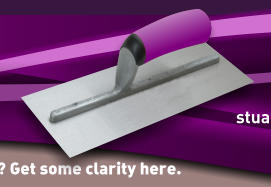


It can be a daunting experience entering into work with a tradesman when you don't know the person you are dealing
with and don't know anything about the trade itself or the terminology that comes with it, so hopefully these brief
explanations will give you some confidence when dealing with a plasterer. This list is by no means exhaustive but it
does explain the most commonly used terms.
This is the term used to describe the application of a thick background coat of plaster to a brick or block-work
surface prior to skimming.

The set stage is the skimming part of the job, generally only referred to as a 'set' when applied to a 'float' coat, so in
conjunction would be called a 'float and set' which is the process of bringing bare brick and block-work up to the
point of decoration.

This is the process of applying a thin finishing coat of plaster to a thickness of around 3-5mm to an existing
background.


The name of a material but also the process of applying diluted PVA to the wall or ceiling prior to plastering.

The most commonly used bead is a metal edging strip that is generally applied to all external corners to give you a
durable edge resistant to knocks.

This is the joint or crack reinforcement material that comes on a roll and in a mesh form, the most commonly used
form is made of fibreglass and is self adhesive, but cotton and jute are also still in use if somewhat less frequently.

The name for applying plasterboard to walls and ceilings and then finishing then using a joint tape and joint
compound which is then sanded to a paintable finish, no plaster is used.

The two methods for fixing plasterboard, 'tacking' is done by screwing the boards to either timber stud-work or
ceiling joists, 'dot and dab' is fixing the boards to walls using an adhesive compound dabbed onto the substrate in a
series of dots and the board is then pushed onto the compound and made level.

The term given to repairing damage in plasterboard or plasterwork.
This information just scratches the surface, other very useful sources of information are online forums, three of
which I have put links to here. You can get great information and advice from knowledgeable people on all so have
a look. Registration is free, quick and easy and only necessary if you intend to leave a message.











































